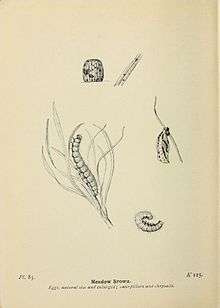Meadow brown
| Meadow brown | |
|---|---|
_female.jpg) | |
 | |
| both females | |
| Scientific classification | |
| Kingdom: | Animalia |
| Phylum: | Arthropoda |
| Class: | Insecta |
| Order: | Lepidoptera |
| Family: | Nymphalidae |
| Genus: | Maniola |
| Species: | M. jurtina |
| Binomial name | |
| Maniola jurtina (Linnaeus, 1758) | |
The meadow brown (Maniola jurtina) is a butterfly found in the Palearctic ecozone. Its range includes Europe south of 62 N, Russia eastwards to the Urals, Asia Minor, Iraq, Iran, North Africa, and the Canary Islands. The larvae feed on grasses.
Description
There is marked sexual dimorphism in this species. Males are less colorful, with smaller eyespots and much reduced orange areas on the upper forewings. They are also much more active and range far about, while females fly less and often may not away from the area where they grew up.
A variable number of smaller eyespots are usually found on the hindwing undersides. These may number up to 12 per individual butterfly, with up to 6 on each wing, but sometimes none. The factors that govern polymorphism in this trait are not resolved, although a number of theories have been proposed (Stevens 2005). On the other hand, the evolutionary significance of the upperwing eyespots is more obvious: The more active males have a markedly more cryptic upperside pattern, whereas the females have more opportunity to present their eyespots in a sudden display of colors and patterns that presumably startle predators so the butterfly has a better chance of escaping. Some specimens are bi-pupilled.
 Small Heath (for comparison)
Small Heath (for comparison)- Female
- female
_male_underside_no_spots.jpg) female
female- Mating
_mating.jpg) Mating
Mating First instar caterpillar
First instar caterpillar Pupa
Pupa

Similar species
Similar species are the gatekeeper (which prefers to rest with its wings open) and the small heath (which is smaller). More similar are the dusky meadow brown Hyponephele lycaon (smaller, male androconial area obliquely directed and divided into three parts by veins Cu1 and Cu2, female with two ochreous ringed eye-spots) is otherwise very similar, Pyronia janiroides, Hyponephele moroccana Hyponephele lycaon and Hyponephele lupina. Most problematic is the cryptic species complex of Maniola (Maniola telmessia, Maniola nurag, Maniola chia, Maniola halicarnassus, Maniola cypricola).

Description of egg, larva and pupa
The egg, laid on a blade of grass as shown (Plate 85), is upright and ribbed ; the top is flattened, with an impressed ring thereon. Colour, whitish-green inclining to brownish yellow as it matures, and marked with purplish-brown.The caterpillar is bright green, clothed with short whitish hairs ; there is a darker line down the back, and a diffused white stripe on each side above the reddish spiracles ; the anal points are white. Head rather darker green, hairy.The chrysalis is pale green, marked with brownish on the wing-covers, the thorax is spotted with blackish, and the points on the body are brownish. Suspended, and with the old skin attached.(South, 1906).
Food plants
Recorded larval foodplants include rough meadow grass Poa trivialis, smooth meadow grass Poa pratensis, Festuca spp., bents Agrostis spp., and cock's-foot Dactylis glomerata, false brome Brachypodium sylvaticum, downy oat-grass and Helictotrichon pubescens. Less specific records of Poa, Bromus, Festuca, Milium, Brachypodium, Lolium, Avena, Alopecurus, Anthoxanthum.
Adults are nectar- feeding on a wide spectrum of plants including Centaurea , Cirsium, Leontodon, Erica, Rubus, Heracleum, Eupatorium, (sensu lato) Origanum, Senecio, Scabiosa, Succisa, Ligustrum, Filipendula....
Flight time
The meadow brown is univoltine and adults emerge over a long period (spring, summer, autumn). Some individuals have a short larval development time and produce late adults. This is genetically controlled.
Habitat
Because of the vast distribution habitats are hard to define but broadly are forest edge, forest-steppe and meadow steppe habitats up to 2,000 m above sea level, cultivated lands (meadow, forest plantations, parks, orchards).
Subspecies
- Maniola jurtina hispulla (Esper, 1805) Portugal, Spain
- Maniola jurtina hyperhispulla (Thomson,1973) Maltese Archipelago (Gozo).
- Maniola jurtina jurtina (Linnaeus,1758) Europe (Type locality Sweden), Spain.
- Maniola jurtina janira Linnaeus, 1758 Central Europe, Russia, Latvia, Poland, Slovakia, Hungary, Ukraine, Middle and South Urals Kazakhstan, West Siberia (Kurgan).
- Maniola jurtina strandiana Oberthür, 1936 South Europe, Caucasus Major and Minor Crimea, Armenia, Azerbaijan
- Maniola jurtina persica LeCerf, 1912 (=? ghilanica LeCerf, 1913) Kopet-Dagh, Azerbaijan, Turkmenistan
- Maniola jurtina phormia (Fruhstorfer, 1909) Slovenia
References
| Wikimedia Commons has media related to Maniola jurtina. |
- Stevens, Martin (2005): The role of eyespots as anti-predator mechanisms, principally demonstrated in the Lepidoptera. Biol. Rev. 80(4): 573–588. doi:10.1017/S1464793105006810 (HTML abstract)
- Andrea Grill, Rob de Vos, Jan van Arkel, 2004 The shape of endemics: Notes on male and female genitalia in the genus Maniola (Schrank, 1801), (Lepidoptera, Nymphalidae, Satyrinae) Contributions to Zoology, 73 (4) (2004) online here
External links
·